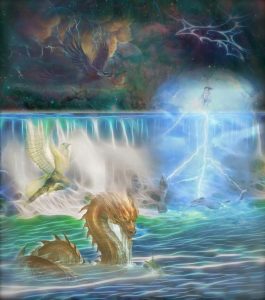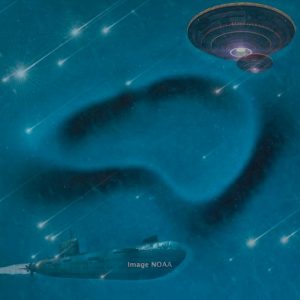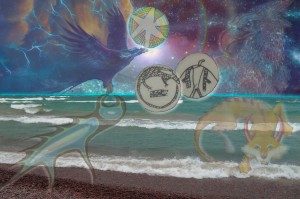Anish Kapoor Opens the Door
Modern Artist Creates Monuments that Transcend Space & Time
“I am interested in sculpture that manipulates the viewer into a specific relation with both space and time. Time, on two levels; one narratively and cinematically as a matter of the passage through the work, and the other as a literal elongation of the moment.”
- Anish Kapoor

For thousands of years art and architecture has allowed the viewer opportunities to glimpse the past, feel in the present, and contemplate the future. Artists for millennia have been creating monuments that sparked the imagination and lifted the soul. Today there is a gentleman who appears to be picking up where the ancients left off, creating mind bending pieces of transformational art that transcend both time and space! Over the last couple of decades Mr Anish Kapoor has brought into fruition some of the most incredible monuments on the planet. Kapoor is a sculptor who was born in Bombay (Mumbai), and has lived and worked in London since the early 1970s. Today he has sculptures and artworks spanning the globe and is considered one of the modern days most influential artists.
What Anish Kapoor has perceivably done is to take sculpture to the “next level”, and sometimes beyond! The previous statement can be taken in a rather literal fashion considering the majority of Kapoors works do have aspects to them that appear to transcend space and time. Many times working with mirror like surfaces containing concave and convex shapes, he creates portal-like sculptures that give the viewer (you) the perception that your time & space has been altered! These are consciousness gateways where we can perceive and contemplate the world(s) around us in a whole new light.
An unfortunate scenario often times occurs within the art community. The artists and in particular their art, many times goes under appreciated, and shall we say under utilized, until it gains recognition sometimes hundreds of years later. This in part is the reason for the following article. The monuments that Anish Kapoor is now imagining, and bringing to light right in front of our eyes are meant to be recognized, and utilized now! Anish’s mirror like portals give us the opportunity to experience reflections (sometimes personal, other times collective). His wormhole imagery gives our consciousness the chance to transcend time and space and achieve a state of contemplation. Where are we headed? What is on the other side? How do we get there? These are all questions we can reflect upon, and contemplate while in the presence of Kapoor’s otherworldly sculptures.
The following pages contain a photographic essay documenting two of Kappor’s separate, yet connected, artistic styles. First we will reflect on Anish’s mirror-like portals, and then journey through his cosmic wormhole imagery. Prepare to open new consciousness doorways, and to transcend through the Cloud Gates as we explore Kapoor’s gifts to humanity.
Mirror Portals
C – Curve created by Anish Kapoor has been installed, and reinstalled at several different locations. Kapoor has said of C-Curve that he wants to encourage the viewer to reassess their relationship with the space around them.



Sky Mirror is a breathtaking, 35-foot-diameter concave mirror made of polished stainless steel that reflects its surroundings giving the impression of a portal to a similar, yet different world. This optical object changes through the day and night and is an example of what Kapoor describes as a “non-object,” a sculpture that, despite its monumentality, suggests a window or void and often seems to vanish into its surroundings. As with many of Kapoor’s sculptures this is a traveling exhibit giving many cities and individuals the opportunity to reflect and even vanish into their surroundings.


Tall Tree And The Eye bubbled towards the heavens in the courtyard of The Royal Academy of Arts in London. The steel structure, an arrangement of 76 shiny spheres which bubble up to the level of the surrounding Palladian buildings, is inspired by the words of the German poet Rainer Maria Rilke. “It is a conjunction of images I have always loved in his Sonnets to Orpheus and this work is, in a way, a kind of eye which is reflecting images endlessly,” says Kapoor.


Cloud Gate is located in the heart of Chicago’s Millennium Park (Stargate Chicago). It measures 66-feet long by 33-feet high. Cloud Gate was to be symbolic of a large drop of liquid Mercury according To Anish Kapoor. Symbolically speaking alchemists were convinced that mercury transcended both the solid and liquid states, both earth and heaven, both life and death. Liquid Mercury can also be symbolic of the planet as well as the god Mercury / Hermes. Hermes in Greek mythology, is the god of boundaries and of the travelers who cross them, the messenger from the gods to humans, between the earthly realms & heavenly realms.


The sculpture challenges the visitors perception by distorting and deforming the surrounding architecture. The sculpture also warps viewers’ perception of time by changing the speed of movements such as the passing of clouds.” According to Kapoor he was,” interested in a sculpture that manipulates the viewer into a specific relation with both space and time.” Not only does Cloud Gate reflect the outside world, but also makes it seem to dematerialize from beneath. When you go underneath ‘Cloud Gate’ and look up you are afforded the opportunity to watch yourself swirl and transcend through Cloud Gate Portal! Millions of people observe the Cloud Gate portal every year. Not only is the gateway creating a ceremonial space, but also building a sacred landscape. On this particular piece of land millions of people could and can have a transformation of consciousness . The experience of going through the cloud gate portal has the power to make a person begin to view not only the art and architecture from a new perspective and in a new light, but also ourselves and the world around us.


Through The Wormhole

Marsyas by Anish Kapoor was displayed in Turbine Hall of the Tate Modern Museum in London. The work itself is very large, over 150 meters long, and is composed of three steel ‘rings ‘with a PVC membrane stretched between them. Marsyas highly resembles a classic wormhole. The sculpture is named after Marsyas, a satyr, who, according to Ovid’s Metamorphoses, challenged Apollo to a musical contest and was punished for his presumption with the horrendous torture of being flayed alive. In some versions of the tale, his blood formed a river that came to bear his name; Kapoor says the flowing, translucent blood-red fabric of Marsyas is supposed to be read as skin stretched tight to form a sky above the viewer.


Widow graces Rome’s latest venture, the Maxxi, or the National Museum of the XXI Century Arts. Any Questions??



The Farm is located in Kaipara Bay, north of Auckland, New Zealand. The “Farm” is the name of both the location as well as the installation. Kappors’s Incredible & immense hillside monument once again resembles a wormhole, or possible even a trumpet of sorts. The ellipses are orientated one horizontal, the other vertical. The sculpture passes through a carefully cut hillside providing a kaleidoscopic view of the beautiful Kaipara Harbor at the vertical ellipse end, and the hand contoured rolling valleys and hills of “The Farm” from the opposite horizontal ellipse.



Temenos is Greek for a sacred piece of ground, and is located at Middlesbrough. Temenos is Kapoor’s artistic take on an enormous butterfly net. The Butterfly is a symbol of transformation transcending from the grounded pupil form of the caterpillar to the transformed enlightened butterfly. Symbolically Temenos is creating “a sacred piece of ground” where visitors can be transformed.



Arcelormittal Orbit is Anish Kapoor’s & Cecil Balmond’s vision of a spiraling tower that reaches into the heavens. It will be brought into fruition, and become the iconic center piece for the 2012 Olympics in London. The Orbit will be centrally located within Olympic Park allowing visitors to transcend it’s spiral stairway into the heavens, achieving breathtaking vista views. Kapoor said one of the influences in his design for the tower was the Tower of Babel the sense of “building the impossible” that “has something mythic about it.” The spaces inside the structure, in between the twisting steel, are “cathedral like”, according to Balmond, while according to Kapoor, the intention is that visitors will engage with the piece as they wind “up and up and in on oneself” on the spiral walkway.

It almost appears these artists may have tapped into a cosmic consciousness, bringing into existence a modern version of the Tower of Babel, the Gateway to the Gods, in the heart of London’s 2012 Olympic Park. Did they bring into fruition a “Cosmic Doorway”?
Friend and colleague Dr. Mark Gray points out, “Started in Greece, The Olympics feature the best athletes in the world competing in a wide range of sports every 4 years. Cities are turned into battlefields for the Gods, complete with stadiums and Inspirational Art and Architecture to uplift the Spirits of athlete and spectator alike. The Olympic Parks are Cosmic Doorways.”
http://cosmicdoorways.net/CosmicDoorways/CD-OLYMPIC_PARKS.html




Mr. Anish Kapoor has truly been a catalyst in taking art and architecture to the “next level”. He has created mythological monuments that surely do, and will, transcend time and space. In particular his portal – like mirrors and and cosmic wormhole imagery allowing those experiencing the art to reflect, contemplate, and speculate on the world(s) around them. Kappor has gifted this planet with Consciousness Doorways where each and every one of us have an opportunity to “tune in” and connect with realms beyond our wildest imaginations. It may be no coincidence that Kapoor’s masterpiece, the Orbit (symbolic of the Tower of Babel), is spiraling towards the heavens in a wormhole fashion just in time for the 2012 Olympics. Unlike any other time in history, now may be the time we all truly need to begin re-connecting with these new and modern Gateways to the Gods. In Kapoor’s own words……..
“I am interested in sculpture that manipulates the viewer into a specific relation with both space and time.”
“Do you know there’s a wonderful Christian idea in which Thomas stretches his hands out to try to touch Christ’s wound and Christ says ‘Noli me tangere’ (do not touch me). What your eyes see your hands will always try to affirm. Much of dealing with the non-material is about this confusion between the hand and the eye, the ear and the eye, when the thing that you look at is uncertain, your body demands a kind of readjustment, it demands certainty. Something happens to where you are, to space; time changes. Time, I think, becomes slower. The mystical truth of art is time.”
“I’m thinking about the mythical wonders of the world, the Hanging Gardens of Babylon and the Tower of Babel. It’s as if the collective will comes up with something that has resonance on an individual level and so becomes mythic. I can claim to take that as a model for a way of thinking. Art can do it, and I’m going to have a damn good go. I want to occupy the territory, but the territory is an idea and a way of thinking as much as a context that generates objects.”
“Artists don’t make objects. Artists make mythologies.”
“I think I understand something about space. I think the job of a sculptor is spatial as much as it is to do with form.”
“The idea is that the object has a language unto itself.”
“There’s something imminent in the work, but the circle is only completed by the viewer.”








